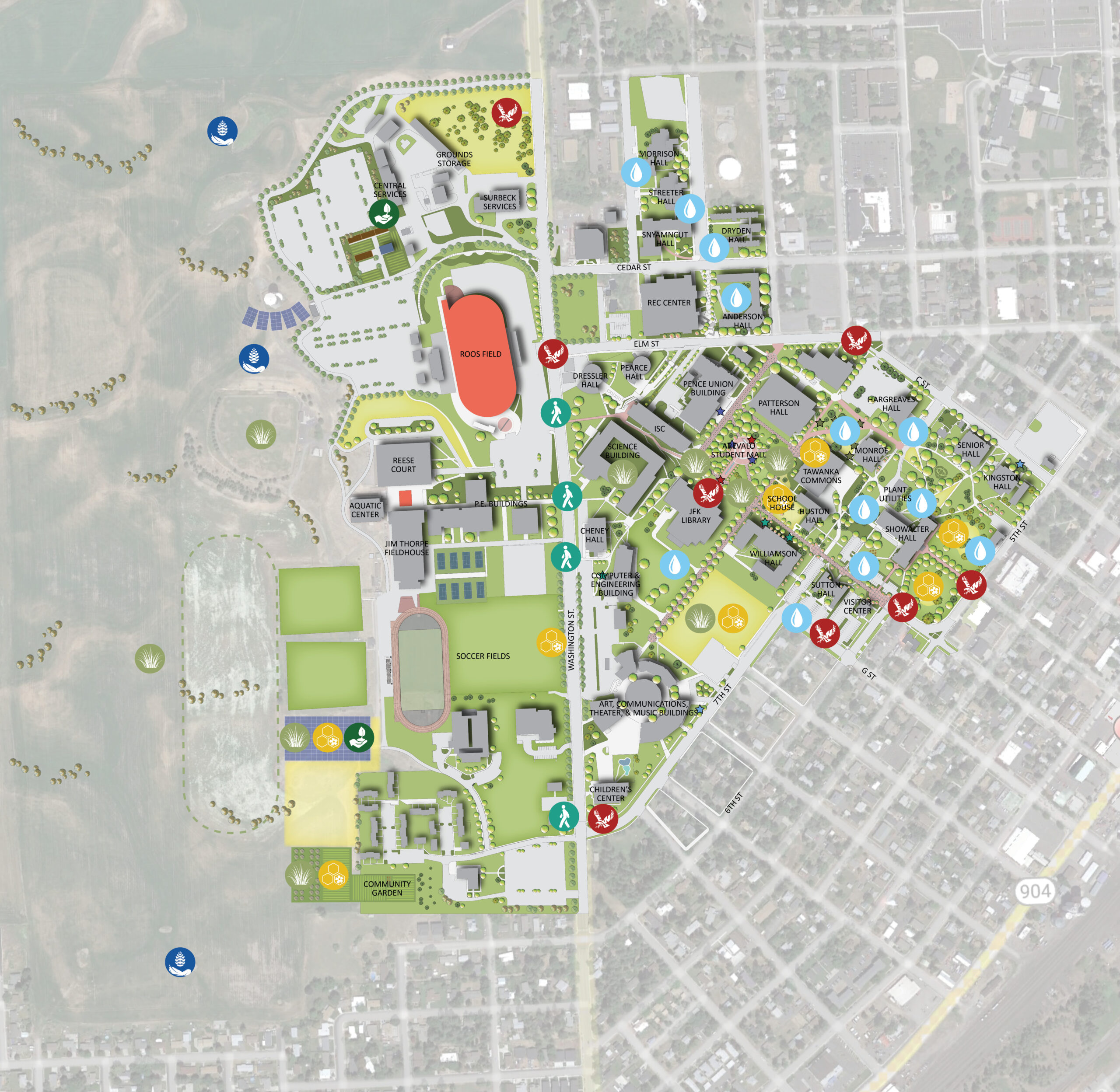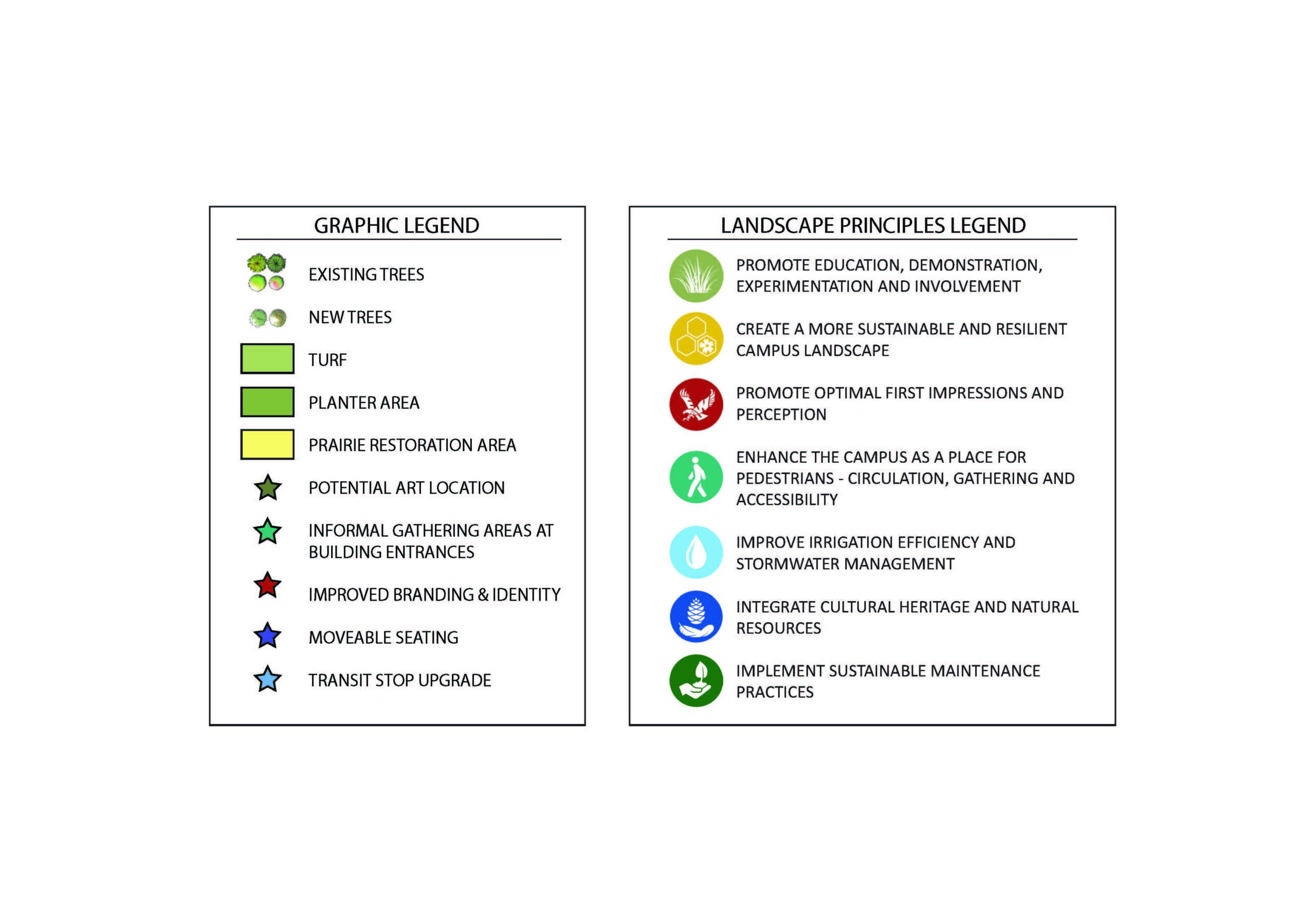Representative Sustainability Enhancement projects have been identified with recommendations for renovations and maintenance for EWU’s campus landscape. The series of icons reference implementation of specific Master Plan Principles within each project.
Sustainability Enhancement Projects
Campus Map

Legend

The One Room School House | Cheney Normal School Heritage Center: Vernacular Landscape Restoration
Before Enhancement
Built in 1905, the One Room School House, formally known as the Jore School, was found in the woods near Newport, Washington. It was relocated to EWU and restored with care and attention to historical accuracy. The School House represents EWU’s beginnings in 1890 as the first institution in Washington for teacher instruction.
Description: While the building is historically accurate, the landscape does not reflect the landscape vernacular of the region’s original schools and homesteads. The project will convert traditional irrigated turf grass to prairie grasses and forbs for pollinators and to demonstrate prairie restoration within the campus core. The irrigation system will be modified to provide functional control of the irrigation around the building site. The prairie restoration and irrigation modification will reduce water use and long term maintenance. The hardscape walls and foundation planting will be strategically modified to integrate native shrubs and perennials as well as plants that were common to Eastern Washington homesteads. Native plants may include native lupine, serviceberry, mockorange, mahonia, and sticky geranium. Introduced historic plants may include bearded iris, flowering quince, lilacs, and other adapted
After Enhancement
Enhancement Strategy:
- An extensive educational outreach program should be created and implemented to ensure a broad understanding of the project and intent.
- The existing irrigation system should be modified to isolate the site from adjacent turf grass. Twelve inch high pop-up rotors should replace the existing irrigation to provide as needed irrigation for the prairie areas.
- The foundation plantings would be irrigated with drip or bubblers. Reduce watering, power rake and overseed with fine fescue mix. Control weeds for first year and then inter-plant with student grown native forbes in masses throughout grass area.
Irrigated Turf Reduction
Before Enhancement
Small lawn areas are typically inefficiently irrigated and difficult to effectively maintain. Curves and narrow strips generally result in irrigation overspray onto walks, wasting water. Reducing irrigated turf in these areas can reduce water use, the need for fertilizer applications, and weekly mowing.
After Enhancement
Description: Remove irrigated grass, modify irrigation, and plant with native and adapted plants from campus plant list.
Enhancement Strategy:
- Install informational signage.
- Shut down watering, power rake. Remove existing lawn with application of a broad spectrum spray or applying a weed barrier fabric and thick mulch to smother the grass.
- Provide supplemental irrigation as necessary for trees during turf grass removal.
- Once the grass is eliminated, reduce grades at sidewalks and curbs by 3-4” to accommodate organic mulch thickness.
- Install drip irrigation tubing, 4” below finish grade and pin to maintain depth.
- Apply 2” of topsoil / compost mix.
- Plant native and adapted landscape plants spaced at 80% of mature width to fill in and shade out weeds. Plant selection depends on location. Do not plant within 6’ of existing trees and omit plants when large roots are found.
- Extend drip tubing to individual plants. Emitters to be 1/2 gph to allow to soak in around plants.
Tawanka Commons Irrigated Turf Reduction and Pollinator Plantings
Before Enhancement
The existing lawn area around the Tawanka Commons entry is generally small, inefficiently irrigated, and difficult to effectively maintain.
Description: The entry can be enhanced with the removal of turf grass, resulting in reduced water use and sustainable identity. Remove irrigated grass, modify irrigation, and plant with native and adapted plants from campus plant list.
After Enhancement
Description: Remove irrigated grass, modify irrigation, and plant with native and adapted plants from campus plant list.
Enhancement Strategy:
- Install informational signage.
- Shut down watering, power rake. Remove existing lawn with application of a broad spectrum spray or applying a weed barrier fabric and thick mulch to smother the grass.
- Provide supplemental irrigation as necessary for trees during turf grass removal.
- Once the grass is eliminated, reduce grades at sidewalks and curbs by 3-4” to accommodate organic mulch thickness.
- Install drip irrigation tubing, 4” below finish grade and pin to maintain depth.
- Apply 2” of topsoil / compost mix.
- Plant native and adapted landscape plants spaced at 80% of mature width to fill in and shade out weeds. Plant selection depends on location. Do not plant within 6’ of existing trees and omit plants when large roots are found.
- Extend drip tubing to individual plants. Emitters to be 1/2 gph to allow to soak in around plants.
- Apply 2” of topsoil / compost mix.
- Plant native and adapted landscape plants spaced at 80% of mature width to fill in and shade out weeds. Plant selection depends on location. Do not plant within 6’ of existing trees and omit plants when large roots are found.
- Extend drip tubing to individual plants. Emitters to be 1/2 gph to allow to soak in around plants.
- Apply pre-emergent and then 4” of fine bark mulch.
Irrigated Turf Reduction and Identity Enhancement
Before Enhancement
Many existing lawn areas around parking lots are narrow, include stormwater swales, and are generally inefficiently irrigated and difficult to effectively maintain.
Description: Many parking areas provide an initial impression of EWU. The impression and parking lot can be enhanced with the removal of turf grass, resulting IN reduced water use and sustainable identity. Remove irrigated grass, modify irrigation, and plant with native and adapted plants from campus plant list.
After Enhancement
Enhancement Strategy:
- Install informational signage.
- Isolate turf area to be converted. Shut down watering, power rake. Remove existing lawn with application of a broad spectrum spray or applying a weed barrier fabric and thick mulch to smother the grass.
- Provide supplemental irrigation as necessary for trees during turf grass removal.
- Once the grass is eliminated, reduce grades at sidewalks and curbs by 3-4” to accommodate organic mulch thickness.
- Install drip irrigation tubing, 4” below finish grade and pin to maintain depth.
- Apply 2” of topsoil / compost mix. Install 4-6” of rock mulch at inlets to reduce erosion.
- Plant native and adapted landscape plants spaced at 80% of mature width to fill in and shade out weeds. Plant selection depends on location. Do not plant within 6’ of existing trees and omit plants when large roots are found. Plants that are durable, resistant to deicer and snow piles should be selected for these areas.
- Extend drip tubing to individual plants. Emitters to be 1/2 gph to allow to soak in around plants.
Identity Enhancement: F Street Gateway
Before Enhancement
The corner of 6th Street and ‘F’ Street is one of the most important opportunity locations on campus to reinforce EWU’s identify. Students from the surrounding neighborhoods enter the campus and use the main promenade and Sustainability Spine to access the core of campus.
Description: Install a new EWU monument, similar in scale to the one located at the Child Care Center. This main entrance to the campus circulation system is enhanced with the monument and low water use plantings. Remove irrigated grass, modify irrigation, and plant with native and adapted plants from campus plant list.
After Enhancement
Enhancement Strategy:
- Install informational signage.
- Isolate turf area irrigation and construct monument sign. Install mow curb around planting area to protect sign from mowers and irrigation overspray.
- Reduce grades at sidewalks and curbs by 3-4” to accommodate organic mulch thickness.
- Install drip zone and irrigation tubing, 4” below finish grade and pin to maintain depth.
- Apply 2” of topsoil / compost mix.
- Construct new campus monument.
- Plant native and adapted landscape plants spaced at 80% of mature width to fill in and shade out weeds. Plant selection depends on location.
- Extend drip tubing to individual plants. Emitters to be 1/2 gph to allow to soak in around plants.
- Apply pre-emergent and then 4” of fine bark mulch.
North Washington Gateway Improvements - Sustainable Plantings and Prairie Restoration
Before Enhancement
The North Washington Gateway is the most important and visible identity gateways for commuter students, faculty, visitors, and sports fans.
Description: Enhance the landscape around the monument to reflect EWU’s commitment to the Prairie Restoration and incorporation of sustainable strategies on campus. The introduction of the prairie landscape type sets the landscape language for connections between the overall Prairie Restoration and the prairie elements on campus.
After Enhancement
Enhancement Strategy:
- Install informational signage.
- Reduce grades at sidewalks and curbs by 3-4” to accommodate organic mulch thickness.
- If possible, install drip zone and irrigation tubing, 4” below finish grade and pin to maintain depth.
- Apply 2” of topsoil / compost mix.
- Plant native and adapted landscape plants spaced at 80% of mature width to fill in and shade out weeds adjacent to monument. Establish prairie with planting of native forbs and grasses.
- Plant seedlings grown on campus in the fall and conduct selective weed control.
Identity and Branding - Eagle’s Flight
Before Enhancement
The Kennedy Library and its grand staircase with flanking ramps is the western terminus of the Arevalo Student Mall. A low wall with “Eastern Washington University” is the eastern terminus. This low wall is separated from the mall by a sunken seating area with concrete steps. The mall is a tremendous space for student gatherings throughout the year with opportunities to set up tables and tents for education and outreach.
Description: The Kennedy Library staircase is in need of structural and accessibility renovations. These renovations are in preliminary design and could incorporate improvements to the art streams’ mechanical systems.
After Enhancement
Enhancement Strategy:
- The renovation of the staircase should incorporate a sculpture or EWU environmental art that appropriately addresses the eastern terminus wall. This feature, properly integrated into the stream can reinforce the mall’s sense of place and EWU’s brand.
- An opportunity for students to celebrate achievements around an iconic EWU image would be an accessible and recognized ‘Instagram moment’. Renovation of the landscape around
Prairie Restoration Project
Before Enhancement
EWU’s Prairie Restoration project is a one of kind, ambitious project that will dedicate a third of the campus land and resources for students to actively participate in a real-world, multidisciplinary project designed to restore a threatened ecosystem in our region. This major sustainability initiative will restore 120 acres of campus land to its native prairie habitat. In addition to giving students countless learning and research opportunities, the project benefits the environment for the entire region.
Developed in cooperation with representatives from area Native communities, this project will create a model for boosting regional biodiversity while establishing an educational and recreational space that connects visitors to a long-lost landscape.
After Enhancement
Enhancement Strategies:
- Research.
- Strategic prairie planting consistent with research goals
and maintenance support. - Weed control.
- Local seed and plant development.